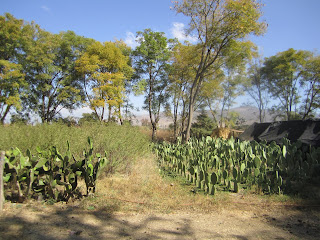During the colonial period, it was a key exporter of Cochinillas, which are a type of dried insects harvested from the prickly pear cactus leaf. Dried and turned to powder, they make a deep red dye which can be changed to a variety of reds, oranges or purples through the addition of an acid or base.
We went to a location where they conserve the old way of harvesting the cochinillas.
First they grow and harvest the prickly pear cactus leaves.
Then they allow the cochinilla insects to reproduce and mature on the harvested cactus leaves.
Eventually the cochinillas are harvested from the cactus leaf.
We got to take a close up look at one cochinilla that had just been harvested in Juliana's hand.
Then we "sacrificed" it by squishing it to see the natural color.
Our guide, Juan, added lime juice to show how adding an acid changed the color from red to orange.
The cochinillas are dried and turned to powder so that they can be used for a variety of different colorants.
In the cochinilla museum, we saw a lot of the applications for cochinilla colorant. These range in uses from dying wool to cosmetics to specialty paints to natural food coloring.
At one time, the value of dried cochinillas to Europe (where it was highly prized in the Catholic church, among others), was higher than the value of gold for the equivalent weight, and therefore it was termed "red gold".









Sehr interessant
ReplyDelete